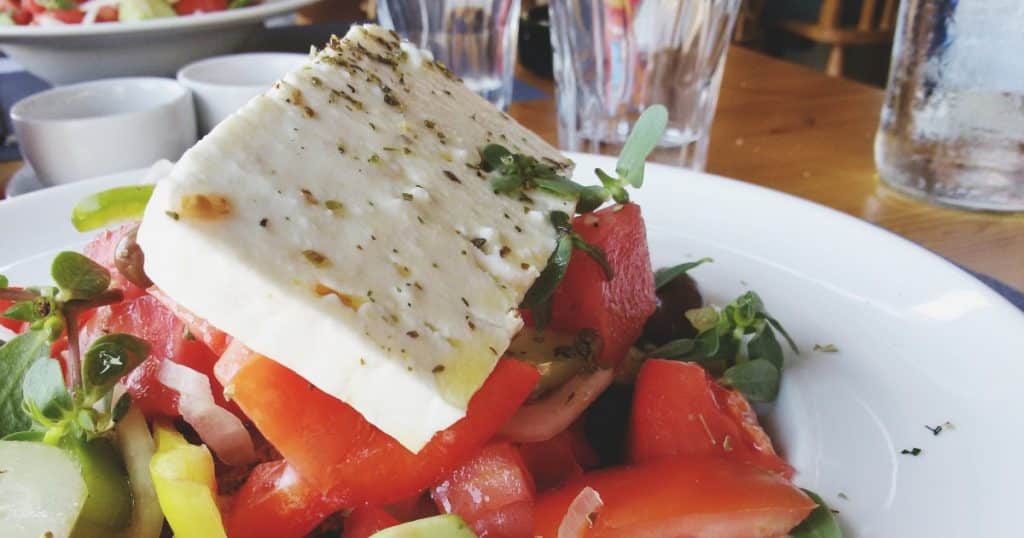You walk into an authentic Greek restaurant, scan the menu, and start noticing a pattern. Salad? Feta. Souvlaki bowl? Feta. Spanakopita? Yep, feta again. You don’t need to count; this crumbly white cheese is everywhere. Feta isn’t just another ingredient; it’s a defining element of Greek cuisine.
Tangy, salty, rich in flavor, and endlessly versatile, feta has earned its spot on nearly every plate that leaves a Greek kitchen.
In this blog, we’re diving into why feta cheese is so essential, how it became a national treasure, and the many delicious ways it’s used in traditional dishes.
The History and Heritage Behind Feta Cheese

Feta isn’t just a Greek favorite, it’s a piece of history. This iconic white cheese goes all the way back to ancient Greece, even earning a mention in Homer’s Odyssey. For thousands of years, feta has been crafted using time-honored techniques, passed down through generations. It’s traditionally made from sheep’s milk or a blend of sheep and goat’s milk, giving it that unmistakable tang and creamy texture.
Today, feta holds a Protected Designation of Origin (PDO) status in the European Union. That means only cheese produced in specific regions of Greece, like Macedonia, Thrace, Thessaly, and the Peloponnese, using traditional methods, can legally be called “feta.” This isn’t just about pride; it’s about preserving authenticity.
What Makes Feta Cheese Uniquely Greek
Feta stands out from other cheeses, and there’s a reason it’s so closely tied to Greek identity. Authentic Greek feta is traditionally made from 100% sheep’s milk, or a blend that includes up to 30% goat’s milk. This specific mix creates the cheese’s signature crumbly texture and bold, tangy flavor.
What also sets feta apart is how it’s stored. Unlike most cheeses, feta is aged and preserved in a saltwater brine. This not only keeps it moist and fresh but also enhances its sharp, slightly salty bite that Greek dishes are known for. And depending on how long it’s aged and the ratio of milk used, feta can range from rich and creamy to firm and crumbly.
Most Popular Greek Dishes Made with Feta Cheese

Here are the top ways it shows up on Greek menus:
- Greek Salad (Horiatiki): No traditional Greek salad is complete without thick slabs or chunks of feta, paired with tomatoes, cucumber, onion, olives, and a splash of olive oil and oregano.
- Spanakopita & Tiropita: These flaky pies are packed with flavor. Spanakopita features spinach and herbs mixed with feta, while tiropita is all about that creamy cheese filling.
- Greek Bowls: Feta is a must-have topping in Greek-style bowls, adding bold, tangy flavor to a mix of rice, grilled vegetables, olives, and lemon dressing.
- Souvlaki Plates: Whether it’s pork, chicken, or beef, grilled meat plates get a creamy, salty finish with crumbled feta on top, perfectly complementing the smoky flavors.
- Sweet & Savory Pairings: You’ll even find feta making an appearance in unexpected ways, paired with watermelon, baked with honey, or crumbled over roasted vegetables.
Is Feta Cheese Healthy? Nutrition and Benefits
Feta cheese isn’t just tasty, it packs some impressive health perks too. As a staple of the Mediterranean diet, it fits right into a balanced lifestyle focused on fresh, whole foods.
- Rich in Nutrients: Feta provides a good source of protein, calcium, vitamin B12, and phosphorus, all of which are important for bone strength and energy metabolism.
- Lower in Fat: Compared to aged cheeses like cheddar, feta typically contains less fat and fewer calories, especially when made from goat’s or sheep’s milk.
- Contains Probiotics: Traditional feta is brined, which helps preserve live cultures (probiotics) that can support gut health and digestion.
- Easily Digestible: Thanks to its unique milk blend and fermentation process, many people find feta easier to digest than cow’s milk cheeses.
So yes, feta cheese is a healthy addition to most diets when eaten in moderation. It brings bold flavor and real nutritional value, without weighing down your meal.
Why Feta Is in Almost Every Greek Restaurant Dish

If you’ve ever browsed a Greek restaurant menu, you’ve probably noticed one ingredient showing up again and again: feta cheese. And there’s a good reason for that.
- Signature Greek Flavor: Feta instantly delivers that tangy, salty taste people associate with Greek cuisine. It’s the ingredient that brings dishes “home” to Greece, whether you’re eating in Athens or Montreal.
- Customer Favorite: Feta is a safe bet that appeals to both Greek locals and international diners. It’s familiar, versatile, and always a crowd-pleaser.
- Perfect Pairing: Whether it’s sprinkled over a Greek salad, crumbled into rice bowls, served on souvlaki plates, or tucked into pies like spanakopita, feta pairs beautifully with meats, grains, veggies, and herbs.
- Vegetarian-Friendly: Feta adds richness and depth to plant-based meals, making it ideal for guests seeking vegetarian or lighter options.
Conclusion
From the hills of Greece to the kitchens of Canada, feta cheese remains one of the most essential and beloved ingredients in Greek cooking. Its bold, tangy flavor, health benefits, and versatility make it a natural fit for everything from salads and bowls to grilled meats and pastries.
Craving that real Greek taste? Head to Souvlaki Authentique, where feta takes center stage across the menu, from classic Greek salads to savory spanakopita and loaded souvlaki plates. With multiple locations across Quebec, it’s never been easier to enjoy a true taste of Greece.














